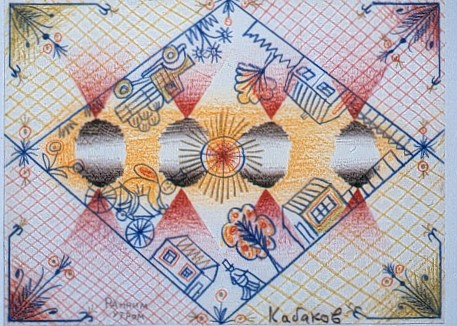25th Anniversary Reflections: Roundtable “Central and East European Art and Culture, 1945-Present” (ed. Susan Snodgrass), 2001
ARTMargins Online is celebrating 25 years! To mark the occasion, the editors invited past ARTMargins Online authors and other writers from the region to select one article from AMO’s online archive of more than 1000 texts, providing a brief introduction that highlights the chosen item’s continued relevance. ARTMargins Online published its first article on January 15, 1999. Today, the publication is one of the largest online archival resources for contemporary art from East-Central Europe and beyond. Our reflection project celebrates AMO’s 25 years, but it also aims to highlight our unwavering commitment to promoting research, criticism, and artistic projects that advance our understanding of contemporary art from the region in a critical global perspective.

Ilya Kabakov. Ornament. 1964.
This roundtable concluded a panel devoted to contemporary and art historical perspectives on Central and Eastern European art and culture from 1945 to the present at the College Art Association Conference in Chicago. Panelists included the late Professor Piotr Piotrowski, whose books popularized the idea of regional art history, as well as several scholars based in the US and in former Socialist Europe: Roann Barris, Matthew Jesse Jackson, Martina Pachmanová, Katalin Timár. The conversation focused on a set of issues that have been discussed in regional art history ever since, including the applicability of postcolonialism to Eastern Europe, the usability of the comparative method, and the conditions of knowledge production about the “former East” and regional art in relation to the Western canon.
A vague in-betweenness, used by the researchers at the roundtable to describe an epistemic position from which both art history and artists in Central and Eastern Europe operate, has since been labeled as a semi-peripheral position in relation to global capitalism. It has also been recognized that the drive for visibility in the West was mistaken for participating in a universal global conversation. The invisibility of the “new Iron Curtain” – the global market – and the complete absence of Ukraine and Belarus from any concept of what constitutes Eastern Europe have all contributed to a number of blind spots in the region’s art history. From this point of view, i.e. after three decades of post-socialist art history in practice, it is interesting to look back at some of the questions that were posed by the roundtable participants and the audience back in 2001:
“Where is the Other within our own culture?”
“Where does that lead? If the goal is to become a part of something, well, that’s good. But what is East-Central Europe becoming in this process?”
“Do you experience any kind of solidarity?”
Central to the ongoing debate alluded to in this exchange has been the economic dimension of the political transformation in the region and its impact on the art scene in Central and Eastern Europe. Piotrowski, for one, explained the significance of feminist art in Poland by pointing directly to the difficult economic situation of women during the transformation period of the 1990s.
The current critical perspective, sensitized to the re-produced invisibilities, helps us to see what was really at stake in this roundtable discussion. The questions posed by the participants were grounded in economic reality. They were political and they are still urgent.
Central and East European Art and Culture, 1945-Present
Four papers by Katalin Timár and Attila Horányi, Matthew Jesse Jackson, Roann Barris, and Martina Pachmanová presented in conjunction with the roundtable were also published on ArtMargins Online:




